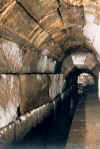
Cloaca Maxima
|
The largest of the still-functioning roman basins, the Cloaca Maxima was the source of a water-drainage channel that ran from the Roman Forum toward the "vicus Tuscus". Following a serpentine route through the Velabro, the Boario Forum, and a wide curve, the canal emptied into the Tiber at Ponte Emilio. Generally, tradition links the initial stretches of the Cloaca to the drainage system that was established by the Tarquin family in the valley of the Roman Forum. The walls of the first section are constructed of stone blocks; and, at various points along the route, minor, capped drains were placed in them. The channel originally ran under open sky, but in the II-I c. BC a small vault hewn in volcanic rock was constructed to cover the current. .The section of the channel at the embankment is 2.7m high, and 2.12m wide; augmented progressively along the route, the end of the channel measures 3.30m high and 4.50m wide. The final track was rectified in relation to the construction of a wall which ran alongside the riverbank. The track of the channel which goes from via del Velabro to the entrance is communal property. As of yet, an in-depth, organic study of the Cloaca Massima has not been undertaken; because of its difficult nature, only the most accessible passages of the channel have been investigated.
|